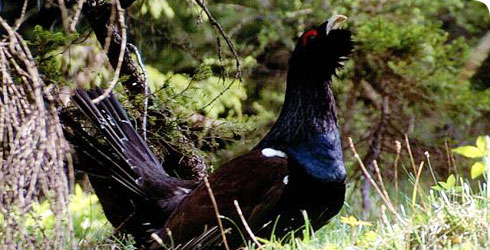Conservation
The capercaillie probably became extinct in Britain in the mid-eighteenth century, largely due to the destruction of native woodland habitat.
In 1837 birds from Sweden were reintroduced into Perthshire, and by the early 1970s there were around 20,000 birds living there. However, urgent conservation action was needed when the population plummeted to just 1,000 in the early 1990s.
The rate of decline was so dramatic that by the mid 1990s they were expected to become extinct in the UK within 20 years. However, the bird has benefited from intensive conservation work, with a survey in 2008 indicating that the population had stabilised at around 2,000 individuals.
A number of possible causes of the decline are:
- a loss of suitable woodland habitat, partly due to over-grazing of blaeberry by sheep and deer - this is the capercaillie's main threat
- increased predation from crows and foxes, especially on breeding females
- increased adult mortality through collisions with deer fences
- an increase in adverse weather conditions during June when chicks are newly hatched, resulting in reduced breeding success
- human disturbance, in part due to forestry operations and the recreational use of forest tracks
Conservation protection and action
The capercaillie is a UK Biodiversity Action Plan (UKBAP) priority species and is on the Scottish Biodiversity List. It is listed on Annex 1 of the EC Birds Directive and is fully protected under the Wildlife and Countryside Act 1981, as amended, which also protects their leks.
The Scottish Natural Heritage (SNH) Species Action Framework’s Five-Year Implementation Plan 2007–2012 aims to increase the population of capercaillie in Scotland to 5,000 birds by 2010 and achieve an increase in the range of the capercaillie.
This framework has resulted in stakeholders, including the Forestry Commission, implementing guidelines when capercaillie or their active leks are found within a working area.
The Royal Society for the Protection of Birds (RSPB) reserves in Scotland manage all their key capercaillie habitats with the birds in mind.
There is much hope for the future recovery of this species, as we know a lot about them, and the habitat management vital for the species is being implemented jointly through industrial, environmental and governmental bodies.
